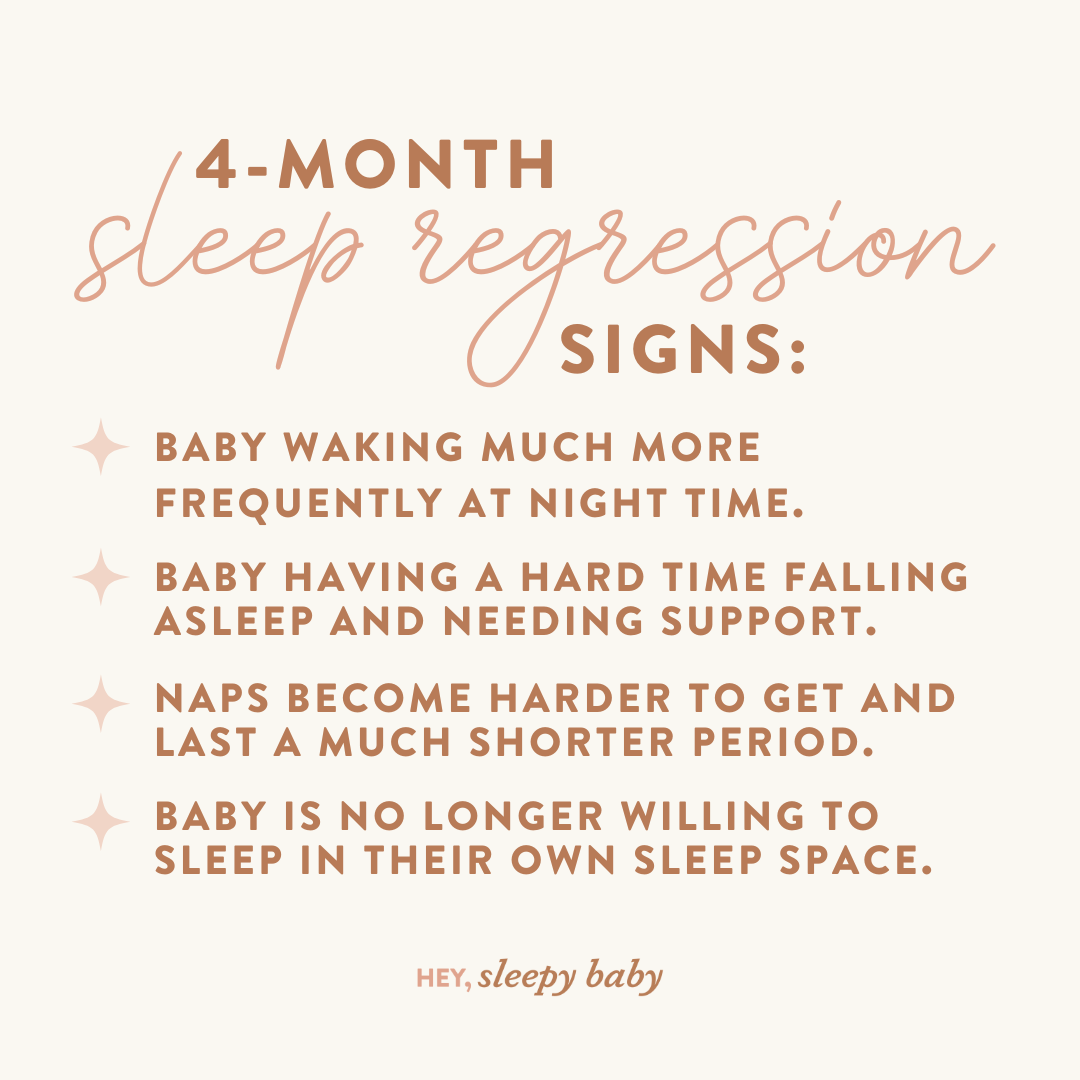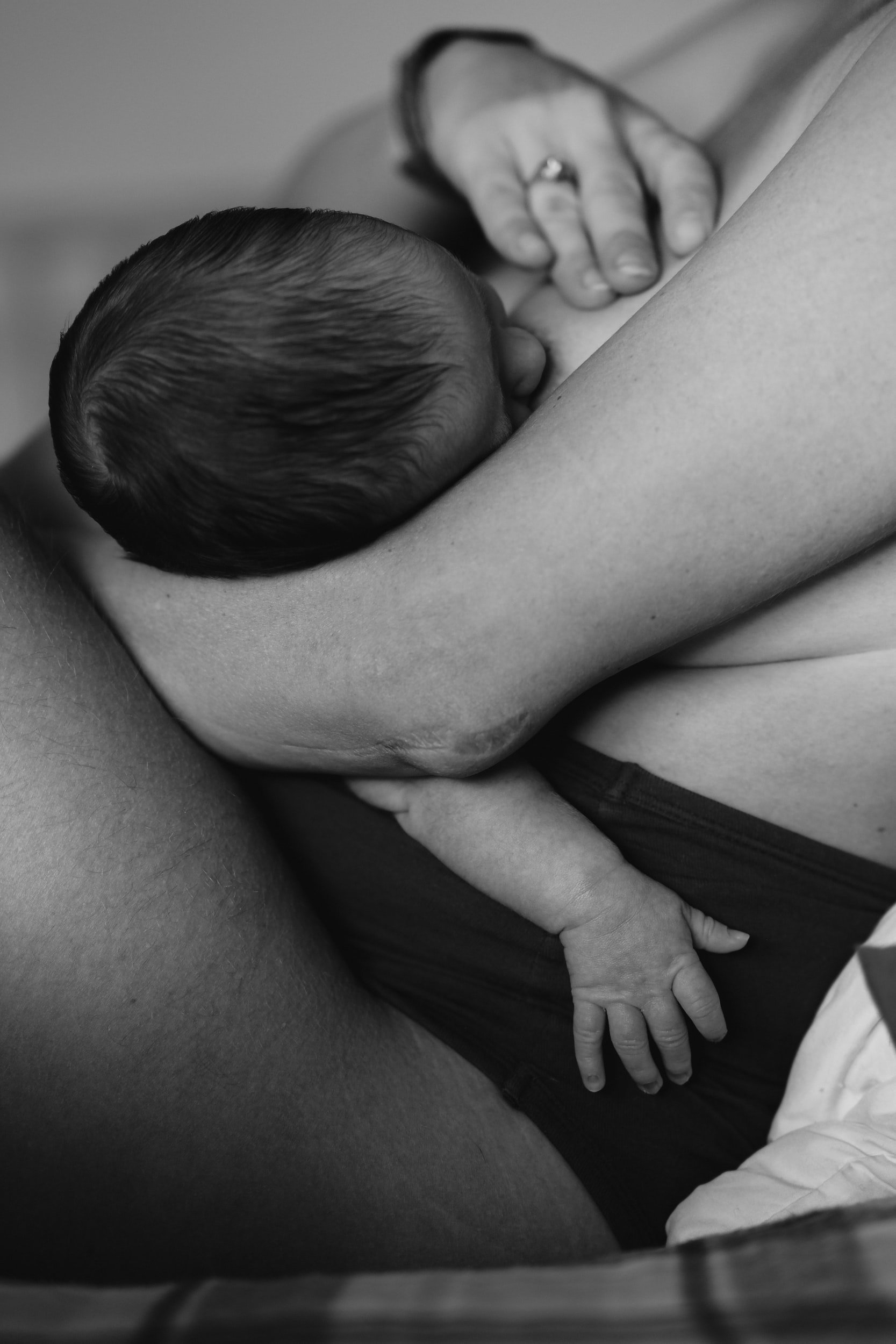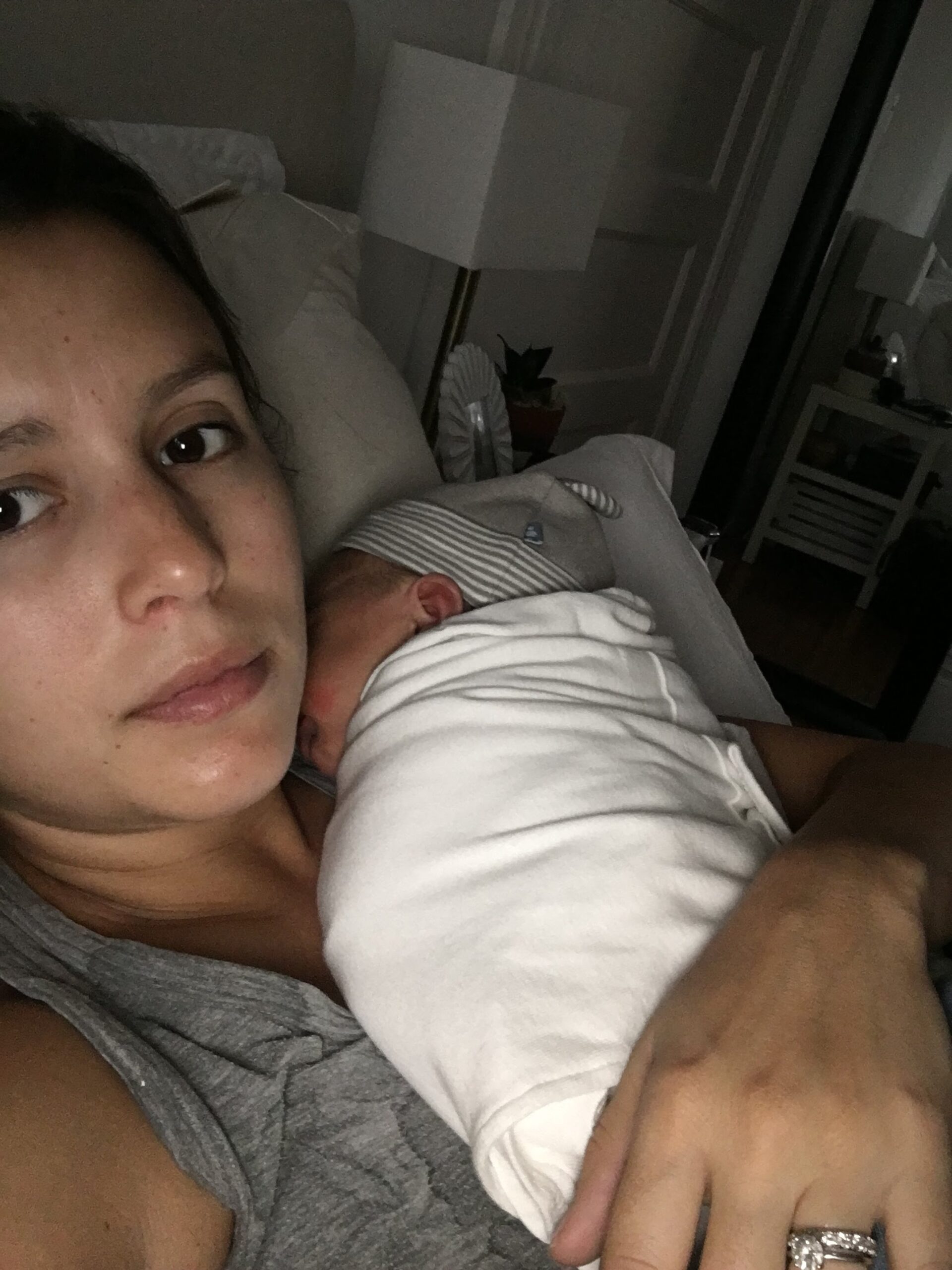I'm Rachael
Mom of 3 & Baby Sleep Expert with Big Sis Energy
& I’VE DONE ALL THE RESEARCH FOR YOU ALREADY.
Better sleep for the entire family
BROWSE COURSES
hey!
The 4-Month Sleep Regression
in this post:
If you find yourself suddenly wondering “why is my 4-month-old waking multiple times at night” this blog is for you! You may be in the midst of something commonly referred to as the 4-month sleep regression. A simple Google search of “4-month sleep regression” gets you more than two million hits; there’s lots of info out there about this and lots of fear around it, too. Many of these articles and blogs about the 4-month sleep regression leave you thinking you’re doomed. No wonder you’re worried! So what is this elusive phenomenon and whom does it affect?

What Is The 4-month Sleep Regression?
The four-month sleep regression is a reference to a period when your baby experiences a developmental change in their sleep as their sleep cycles mature. This might mean that for a while your baby is waking more frequently and for some, it can feel brutal hence why there is such a popular hit rate for Google searches of how to survive the four-month sleep regression! Fortunately, this is one of those baby things that, while definitely tough for some, doesn’t hit everyone so hard. Every baby does go through this change- it’s a permanent change in the sleep architecture of the brain- though not every baby will experience massive sleep disruptions as a result. Lots of parents worry unnecessarily about this stage only to have their baby sail through it. Others say that they hardly noticed a difference because their baby was already waking multiple times during the night. As with anything baby-related, it depends on the temperament of your baby. Often issues such as undiagnosed tongue and airway issues, underlying causes of “colic” or feeding problems are blamed on the “four-month sleep regression” because of the amount of hype and fear there is surrounding this period. These issues shouldn’t be ignored, but they can be overlooked because parents chalk up any bump in the road to the four-month sleep regression.
That being said, the “regression” is REAL and many parents do struggle with their baby’s sleep during this time. You might notice your baby’s sleep doing a complete 180 and it can be tough to cope with.
4-Month Sleep Regression Signs
These are a few things to look out for if you suspect you may have entered the 4-month sleep regression.

-
Baby waking much more frequently at night time.
-
Baby having a hard time falling asleep and needing much more support to fall asleep.
-
Naps become harder to get and last a much shorter period.
-
Often parents report that their baby is no longer willing to sleep in their own sleep space and many families begin cosleeping and bedsharing during this period. If this is something you would like to try make sure you set up for it safely. Information on safe bedsharing can be found here.
I assure you it’s normal, and it’s nothing you’ve done wrong! Don’t worry about everything you read surrounding the “do’s and don’t’s” and “mistakes to avoid when handling your baby’s 4-month sleep regression”. Keeping the mantra in your head that “this too shall pass” is key to getting you through it! Alongside knowing it is only temporary, an understanding of WHY it happens can be helpful. I like to think of this as a PROgression because your baby is NOT regressing in their skills. This is a sign of them moving forward in their development. Their brain is going through a massive change!
Why Does The 4-month Sleep Regression Happen?
Although referred to as the “4-month regression” this developmental change can happen anytime between months 2 and 6. This biological change sees the whole sleep architecture in their brain shift as they move towards a more mature sleep cycle. So what is happening to their sleep cycle?
Newborn babies have two states of sleep:

-
REM-like sleep is called “active sleep.” (During this stage of sleep you may see your baby’s eyes move, their fingers twitch or jerk, they might move their mouths, etc)
-
NREM-like sleep is called “quiet sleep.” (During this stage of sleep the baby is still)
Newborns have naturally immature sleep cycles, and the transition from awake to asleep states is via REM or “active” sleep. Somewhere between two and six months, the sleep cycles mature. THIS is what people are referring to when they talk about the “4-month sleep regression.” So what does this maturation of sleep cycles look like?
For adults and older babies, there are four distinct sleep stages rather than the two we see present in newborns. Rapid Eye Movement (REM) and the three stages of Non-Rapid Eye Movement (NREM). We require more or less of each stage depending on our age. Sleep stages don’t necessarily occur in the same order every time, and we all briefly awaken between each cycle.
REM sleep is where dreams occur. It’s responsible for brain growth and synapse formation, as well as the consolidation of short-term to long-term memories.
NREM sleep has three sub-stages:
-
Stage 1 (Light Sleep)
-
Stage 2 (Light Sleep)
-
Stage 3 (Deep Sleep) It’s associated with cell growth, repair, and rest. It can be hard to wake people from this stage of sleep.
This change happens for most babies between months three and four. The shift in sleep cycle architecture around this age occurs for both nights and naps.
Other Changes In Sleep That Happen Around 4 Months
Before we move on to looking at 4-month sleep regression tips, there are some other reasons sleep gets trickier around 4 months old! Your baby is:

-
Needing less total sleep, going from an average of 14-17 total hours per 24-hour cycle down to 12-15 total hours.
-
Learning to roll: Babies will often start to be able to roll onto their tummy but might get stuck there, leading to lots of frustration. (More about the connection between milestones and sleep regressions here).
-
Gaining more awareness during the day: Babies at this age begin to track people around the room, show social interest and respond to interactions with caregivers.
-
They become more aware of the world around them, thus more potential to become overstimulated, frustrated, and fussy.
-
Some may be starting teething.
-
Increasing nursing (if breastfed) due to the supply-and-demand relationship being established.
-
Keep up your milk production! Up until a couple of months, your supply has been driven hormonally. Now, your baby needs to remove milk for your body to produce more! In addition, prolactin levels are higher at night which means more milk. Your baby might make up for a busy day by fitting in those calories at night.
All of these reasons coupled with the 4-month sleep regression can leave you wanting signs and tips to tackle it fast!
How to Survive the 4-Month Regression
There are several ways to survive the 4-month sleep regression, but these are my top tips:

-
First of all, ensure you are looking after yourself as much as you can and fill your cup as parents. This looks different for everyone. Looking after a newborn baby during the night and day whilst you are amid a sleep regression can be exhausting. As parents, you need to make sure to check in with yourself and take the time to work out what needs are essential to be met for you to show up, be present and as calm as possible and get yourself through this period. For some this can look like taking shifts with your partner, taking turns sleeping in on weekends, ditching the housework, ordering groceries to be delivered, and ordering takeout. It will look different for everyone depending on your own unique self-care needs.
-
Try and be radically honest about how you are feeling. Sometimes it’s not about thriving during this short period but allowing yourself to survive the 4-month regression. Anything you can do to take tasks off your plate and lower the load you are carrying whilst you adjust to this season, will help it feel easier.
-
Rest and nap whenever you get the chance and go to bed early. Things such as yoga, meditation, and breathwork, etc can be helpful tools in giving your body short restorative breaks. It doesn’t have to be perfect, a 5-minute brain break, whenever you can, will help ease things a little.
-
Reassure yourself with little mantras that this isn’t forever, it will pass, just a few more days/weeks and you will be through it. Drop as many demands as you can and be patient and kind to yourself. More ideas and compassionate advice about filling your cup can be found here.
What To Do For Your Baby During The 4-month Regression/Progression?
-
Get outside during the day as much as you can for that natural light exposure and regulating of the circadian rhythm.
-
Give your baby plenty of time on the floor to practice rolling during the day and any skills that they might be trying to accomplish.
-
Keep track of your baby’s sleepy cues and track a few days of wake windows, nap times, and bedtime to see if you can find their optimal rhythm (not schedule!).
-
Always follow cues, not the clock!
-
Use motion, a baby carrier, or contact napping when possible to get your baby to nap for longer. Don’t worry about setting up bad habits, use whatever you need to get you through this period and avoid having an overtired fussy baby. In some seasons they just need more support to get to sleep than others.
-
You may consider setting up for safe bed-sharing to get through this rocky time. You can find more information on this here.
-
Keep consistent, calm routines. Lots of people wonder if they should have a 4-month-old schedule. You can follow a routine and pay attention to wake windows and cues if you’d like, but there’s no need for a strict 4-month sleep schedule! Having loose predictable routines helps to signal to the body it’s time to rest and sleep.
-
Continue to build positive sleep associations so your baby can relax into sleep feeling safe and secure.
If you’d like to start working on crib sleep once you’ve passed the worst of it, grab my Crib & Floor Bed Sleep Guide!If you want a fully comprehensive guide then my Newborn & Baby Bundle can help you know what to expect and how to get great sleep during this time AND every bump along the way from this point forward. Get better sleep for the whole family without sleep training with this one-of-a-kind course.
Featured
Sleep training as a concept is rife within the parenting world. It’s divisive, controversial, hugely popular, and ingrained within Western society. This blog is a one-stop shop for the @heysleepbaby approach and view of the complex world of sleep training!
I can very clearly remember my first week as a mom, about 6 years ago. I was struggling so much with breastfeeding my tongue-tied baby. It was excruciating. I felt like I’d been hit by a bus after a brutal unmedicated labor with 2.5 hours of pushing. I was tearful and exhausted, and felt like my entire life had just been blown up. While I was “happy” to have my baby, it wasn’t the profound bliss I’d been expecting.
Was this helpful? Save it for later!

binge reads
We think you'll love these
You deserve to the
baby stage, not just "survive it."
And you DON'T have to sacrifice your values, ignore your instincts, or force yourself to follow a method you don't align with just to get your baby back to sleep.
I’m here to help you create a restful, sustainable sleep environment that honors both your baby’s needs AND your own (without the stress OR the guilt!) because, no, you don’t have to choose between the two.
enjoy!
BABY SLEEP COURSES →
BABY SLEEP CONSULTS →
Wish you could help your baby sleep better without resorting to sleep training? Download my FREE guide to a good night’s sleep and learn 8 simple, science-backed tips for supporting your child’s needs.
Traditional sleep training methods don’t have to be your solution to better sleep.
SLEEP TRAINING ISN’T THE ONLY WAY TO GET GOOD SLEEP
Hey, I'm Rachael and Hey, Sleepy Baby is for parents who want to get their nights back, without sleep training their babies.
NO ONE TOLD US POD
explorING the untold truths of parenting





